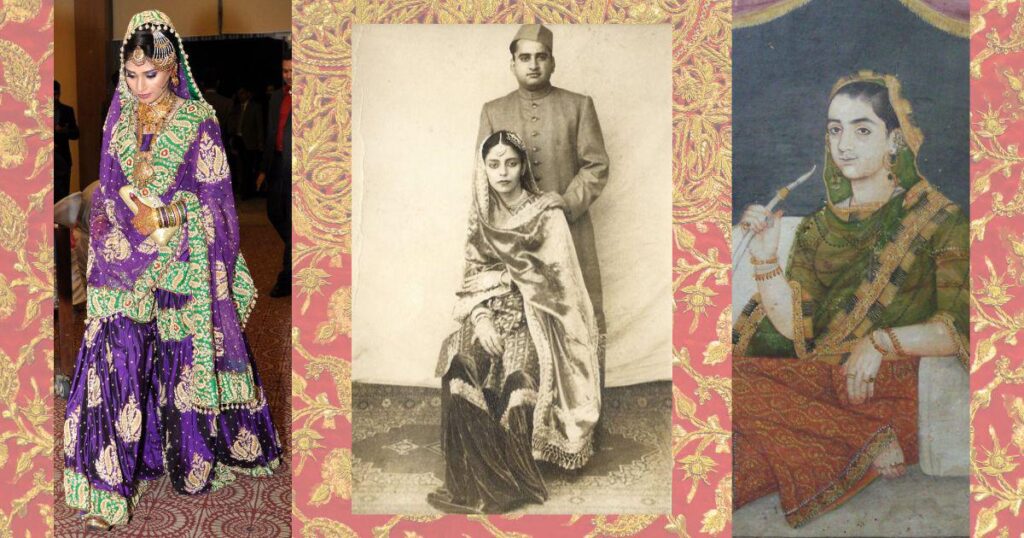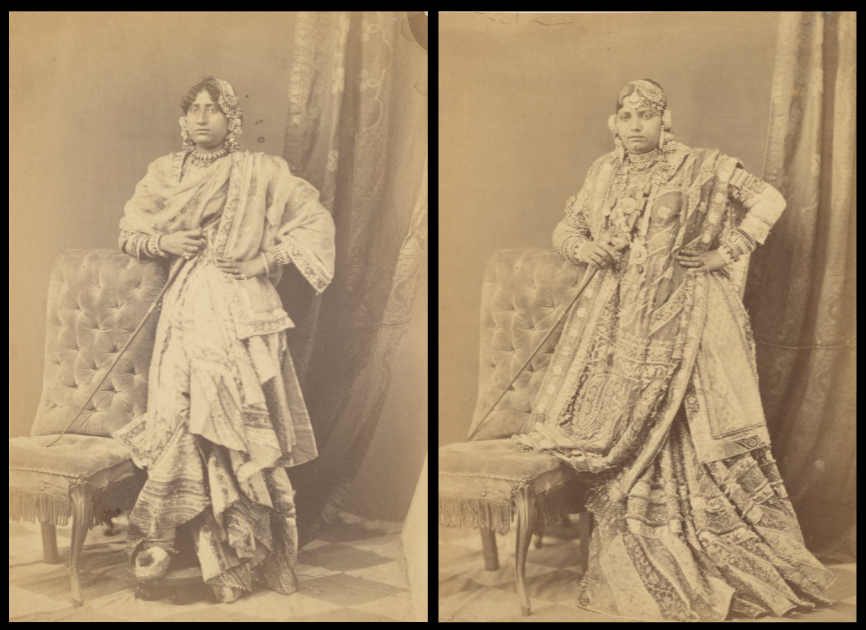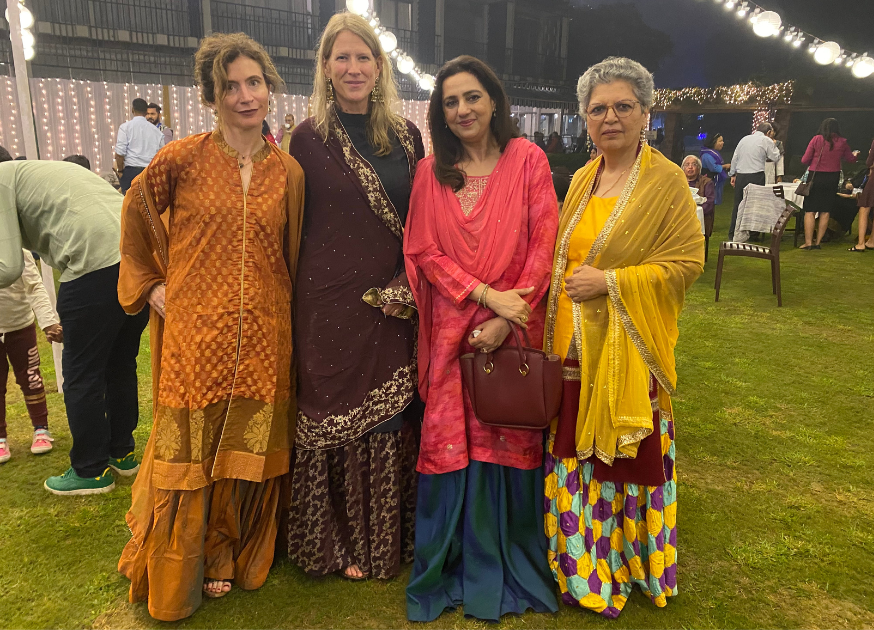Rampur, UTTAR PRADESH :
The ensemble of luxurious silks and embroidery was the quintessential garment for aristocratic Muslim women and generations of brides from my family.

A bride in her ‘nikah’ gharara, a photograph of a couple at a wedding from the 1874 album ‘The Beauties of Lucknow’ by Darogah Abbas Ali and a miniature said to be of “Bahu Begum”, the queen of Nawab of Oudh Shuja-ud-Daula. The backdrop is of a 20th-century silk wedding gown that has been decorated using gilt thread, beads and ‘zardozi’, or embroidery. | Public domain images and Farmina Khan, CC BY-SA 4.0, via Wikimedia Commons
My cousin, Tee, relinquished her oath of singlehood, got her ears pierced and was besieged with intense gharara pangs. She would not, like the rest of us, wait for the groom’s family to bring the wedding gharara. Making your own bridal gharara was unheard of in a conservative Muslim family in 2005, but one could only expect the unexpected from Tee. The besotted groom decided to spin a story about a designer friend making the gharara and we, the sisterhood of cousins, busied ourselves in making Tee’s trousseau and the all-important nikah gharara.
The gharara is a pair of wide-legged pajamas worn with a tunic and a dupatta. A farshi gharara, which Tee craved, has a train that would trail behind on the floor – the “farsh”. For a North Indian Muslim bride, the gharara ensemble is the essence of the nuptials. The groom’s family is judged by the bridal ensemble offered and the bride sees it as a testimony of the love of her future family. My mother wept seeing her sister’s too-plain wedding gharara, feeling sure that the sister would have to endure a tough, married life.
Like Tee, I too desired a farshi gharara trailing behind me, held by my teary-eyed sisters as I walked towards my smiling groom. My in-laws got an elaborate farshi of 20 metres of cloth for me – it had sliced my waist in half and contributed to my delirious happiness.
https://www.instagram.com/p/C-c0hUAS4a8
By the mid-19th-century, inspired by Awadh fashions, the gharara became the embodiment of elegance in the aristocratic Muslim families of North India. Abdul Haleem Sharar writes in Guzishta Lakhnau, a historical work on Awadh, that in the early 19th century, ladies’ pajamas had voluminous skirts fitted at the waist and the hems were tucked in at the waist while walking – a precursor of the present farshi gharara.
Rampur, a Muslim princely state under British colonial rule, was deeply influenced by Awadhi culture. Jan Sahib Rekhtigo’s composition, Musaddas e Tahniyāt e Jashn e Benazir, which describes a festival at the Benazir Palace of Rampur in 1860s, has sketches of tawaif courtesans wearing farshi ghararas with short blouses. The book can be said to be a cultural snapshot of Rampur, reflecting the changes in its Rohilla Pathan culture.
By the end of the 19th century, the farshi gharara, or farshi pāyechā, was essential courtly attire for women attending the zenana durbar to pay respect to Her Highness Begum Rampur. It was quintessential dress for weddings and festivities. At home, the noblewomen generally wore a shorter version of the gharara gathered at the knee with an ankle-length frill. This was the gharara my grandmother wore all her life with a mulmul kurta and a crinkled cotton or georgette dupatta. The colour of the dupatta changed to white when she was widowed – she had to give up the gharara altogether when she became bedridden and was made to wear the more convenient petticoats. She knew, then, that life was dwindling to its logical end for her.
For generations, the brides of my family wore intricately embroidered Rampuri ghararas. Heirloom ghararas with real silver work were bequeathed to daughters-in-law. When my grandparents moved from Rampur to Aligarh, a wedding necessitated several trips to Rampur’s narrow gullies for embroidery and stitching of ghararas. My mother and aunts favoured the shorter gharara and the fashionable single skirt – the sharara – for their wedding trousseaus in the 1970s.
For some reason, all married aunts left their ghararas in their rambling maternal home at Aligarh as they busied themselves with childbearing, household duties and shifted locations to wherever fate and husbands took them. A large tin box was the repository of generational masses of silk ghararas, which were sunned every winter.
The ladies of the bride’s or groom’s family are dressed in ghararas – the married ones wear ghararas from their trousseaus and the singletons borrow, or, if they are lucky, get them stitched for the occasion. We sisters dipped into the gharara box trying out and fighting over the garments before every wedding. There was a hectic mixing and matching of ghararas and dupattas, the kurtas were tightened or loosened to accommodate our body types and metamorphosing bodies.
The bridal gharara was out of bounds, only to be worn by married women. It was too heavy, anyway, to negotiate the rituals and festivities in which we were to play an important role – joota churai, rasta rukai, the dancing and eating. Only an NRI cousin had her own ghararas because her mother decided to get her trousseau made years in advance, even though there was no boy in sight.

Photographs of the “dancing girls” of the “Oudh Court of Lucknow”, from the 1874 album, “The Beauties of Lucknow”, by Darogah Abbas Ali. Credit: public domain images, The New York Public Library Digital Collections.
About 20 years later, confronted with Covid-19 lockdowns and my son’s sudden decision to get married, I wished I had the NRI aunt’s foresight. My daughter had already laid claim to my nuptial ensemble. The bride and bridegroom to be, working from their respective homes, wanted only a simple ceremony before the impending third wave.
Everything could be arranged within a few days, except the bridal gharara. A gharara is generally custom made but there were no markets to get the material from: the embroiderers were ill or had been forced to close their workshops. The option of a store-bought lehenga was unthinkable. A bride had to have her bridal gharara, even in the middle of a pandemic. I was one of the hundreds of desperate Muslim mothers-in-laws attempting to make a suddenly fashionable – thanks to Pakistani wedding Instagram sites – farshi gharara. I was also trying to demonstrate our love by giving our daughter-in-law the nuptial gharara of her dreams.
I was pondering using my sky-blue Banarasi saree and magenta Kanjeevaram to make a farshi gharara when my cousin Mona, the one and only gharara queen of our sisterhood, entered the fray. “You cannot, I repeat, cannot pair a brocade with a tanchoi!” she screamed.
Over long video sessions, she pulled out her old ghararas and educated me on luxurious silks – poth, kamkhab, atlus – which had to be spruced up with dabka, aari, thread, sequins and bead embroideries. Then came the moving parts of the gharara: two legs with the upper half, called the paat, and the lower half, the goat, each with several sub parts and embroidered ribbons, tassels, and lachkas stitched to the seams. The upper tunic has now – thanks to Pakistani fashion – transformed from a short, plain garment to a long and thickly embellished kurta. And finally, the heavily embroidered dupatta.
Mona sent me a slew of Instagram photographs of farshi ghararas that left me hyperventilating. I didn’t even have the material to begin working and Mona said it took two months to get a decent gharara made. Meanwhile, my daughter had shared Kareena Kapoor’s wedding pictures on the family WhatsApp group and the bride and groom could only think of Kareena’s heirloom gharara.
Even in the 1990s, when I got married, there were few people who could stitch a farshi gharara in Rampur. Now, the Rampuri embroidery work has deteriorated, real zardozi work is hardly done here because it is more lucrative to make sequins and bead work. I contacted a gharara maker in Lucknow and sent him pictures.
“You are the 21st person who has called me for this Kareena gharara,” Mr Lucknow gharara sighed on the phone. After lamenting the sad extinction of the tissue silk – the material of Kareena’s heirloom gharara – he suddenly “found” a similar material that we could use. Mona said the best option was to buy the material from him, but the gentleman was loath to part with the material. We broke off with teeth-gushing politeness from both sides. Now, I had no cloth, no farshi in sight and two months to the wedding.
Mona, in lifesaver mode, introduced Nilo appi, an experienced farshi gharara maker from Lucknow. We could send her the brocade and monitor the work over Zoom calls. We made a life-threatening trip to Delhi, double-masked, grabbed brocades and silks in the manner of surgical strikes and couriered the material to Nilo appi.
The next two months were filled with disastrous pictures from Nilo appi and damage control Zoom meetings. The kurta sprouted stereotypical roses on the stem and had to be hidden in masses of nebulous patterns and the pearl beads on the dupatta were too trite. Finally, the kurta was declared irretrievable and the bride had to cover it by wrapping the elaborate dupatta around.
The sisterhood agreed that the red and sea green ensemble looked magnificent – Mona still mourned the kurta – the opulent skirt trailed behind the bride with timeless perfection, as she glided into our lives buoyed with our love.

Writer Claire Chambers, Historian Siobhan Lambert Hurley with author Tarana Husain Khan and historian Rana Safvi at the Jashn-e-Rampur food festival. Credit: Tarana Husain Khan.
Tarana Husain Khan is a writer and food historian based in Rampur.
source: http://www.scroll.in / Scroll.in / Home> History / by Tarana Hussain Khan / September 22nd, 2024








